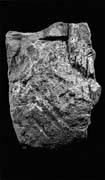Select a site alphabetically from the choices shown in the box below. Alternatively, browse sculptural examples using the Forward/Back buttons.
Chapters for this volume, along with copies of original in-text images, are available here.
Object type: Fragment of cross-shaft [1]
Measurements: H. 18.1 cm (7.1 in); W. 19 cm (7.5 in); D. 13 cm (5.1 in)
Stone type: Unobtainable
Plate numbers in printed volume: 18-19, 24-25
Corpus volume reference: Vol 3 p. 57
(There may be more views or larger images available for this item. Click on the thumbnail image to view.)
A (broad): No mouldings survive. A fragment of human right foot has its toes protruding over a shallow step. Its outline is picked out with a red stripe. Much gesso, and a pink line, remain.
B (narrow) and C (broad): Broken away.
D (narrow): At the upper right-hand corner are traces of a plain moulding. A four-toed animal's left foot is locked by a ring which passes behind the leg. The incised cutting is deep with V-sections. The whole surface has traces of gesso with red pigment. Beneath the plaster is transverse tooling.
The human foot is almost identical with the figure on no. 2 (Ill. 6), but the animal ornament is much cruder. The locking ring is a common device in Viking-age carving throughout Northern England: for example, Sockburn 21 in County Durham and Kirkby Stephen 1 in Westmorland (Cramp 1984, II, pl. 146; Bailey and Cramp 1988, ill. 390).
The piece's chief interest lies in its gesso and pigment (Lang forthcoming). The painting of the surface, though only surviving in red, is in two shades, hinting at a greater variety of colour than one might suppose from a restricted palette. Some outlines were enhanced by bands of colour which would have lifted the low relief.
1. All the pieces from the Minster were discovered as a result of the excavations of 1966-71 by H. Ramm and D. Phillips. They are to be published as a handlist, together with a critical essay, in the forthcoming Royal Commission volume on the excavations. That publication will provide the finer detail of their archaeological contexts, both in a table, and in a description of the excavation of the south transept cemetery.
The following are general references to the stones: Wilson 1978, 142; Hall 1980b, 7, 21; Lang 1988b, 8, 12; Lang 1989, 5.



